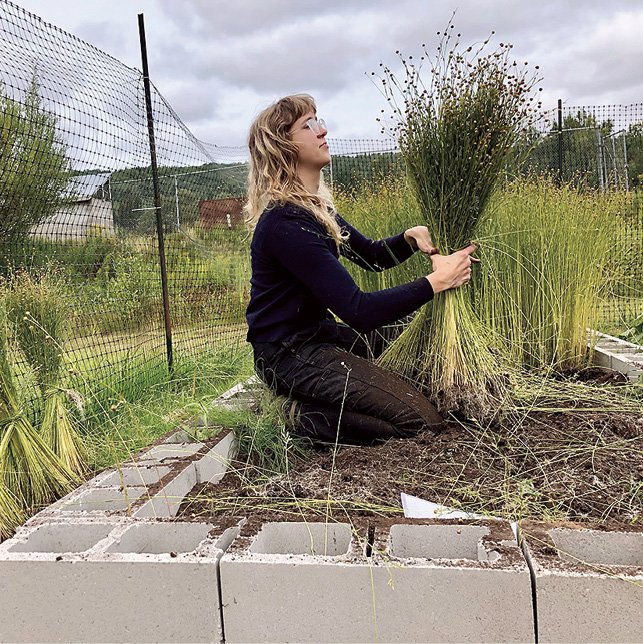In 2020, I grew my first crop of flax up at the Cook County Community Garden in Grand Marais. Flax is the fiber used to make linen yarn. Flax is a bast fiber, which means that its fibers come from the inner bark of the plant. Other bast fibers include ramie, jute, hemp and nettle.
Flax is a beautiful, durable fiber. It has natural luster, incredible tensile strength, and is 20 percent stronger when wet. It also is highly absorbent and dries much faster than cotton, which makes it an excellent next-to-skin fabric. The flax plant can be traced back to the fertile crescent and was cultivated by the Egyptians for textiles—famously shrouds for mummification. Flax eventually spread throughout Europe and was brought to North America in the 1600s by French colonists. Early American textiles were made with linen, and farmers continued to grow flax on their homesteads. The dominance of flax in the United States diminished as cotton production grew through the enslavement of African people and the invention of the cotton gin—the beginnings of fiber industrialization. Cotton remains the choice fiber of the United States, but growing concerns over cotton’s high use of chemical herbicides and water intake has roused interest in linen once again.
As a weaver, I love working with linen because of its luster, crispness and absorbency. The textiles created with linen will last over a century with proper care. As an environmentalist, I appreciate linen’s low water consumption (almost half the amount of cotton), and its ability to outcompete weeds with its dense seeding, negating the need for harmful herbicides. These qualities inspired me to grow and process flax myself, under the mentorship of experienced growers and flax aficionados.
Flax is an annual plant, well-suited for Grand Marais’ short growing season. Last year, I seeded my flax bed at the end of May and harvested it by hand at the beginning of September, which is a typical timeframe for harvest—roughly 100 days. Flax grows well in moderate soil, and its high seeding rate and tall stalks naturally suppresses weeds. Once flax is planted, it needs very little tending or watering. It has beautiful blue flowers that bloom in the morning, follow the sun throughout the day, and drop their petals in the evening. It’s a gorgeous, lush crop that can grow up to 4 feet tall, with the length of one fiber spanning all the way from the blossom end to the roots.
After I pulled the flax from the ground, I had to ret the flax to loosen the fiber from the stem. I chose to dew ret the flax, which means I laid the flax stalks on my lawn and let the morning dew and rain wash over the plant for several weeks. The fibers are attached with pectin, and the retting process literally rots the pectin away so that the fibers can be extracted from the stalk. After the plants are done retting, they are removed from the field and dried until ready to process.
I’ve spent the last few months building processing tools for extracting the flax fiber and spinning it into yarn. The flax stalks have to be broken to remove the woody part of the plant and the outer layer, called chive. Then the broken straw is scraped with a wooden knife to remove the chive that still clings to the plant. Finally, the bundle of flax with its fiber exposed, is hackled, which involves combing the flax fiber through a bed of nails that splits the fiber and removes the shorter fiber pieces, called tow. What’s left is beautiful long fibers called line linen. The staple length of the fiber can be anywhere from 2-4 feet long. These long fibers are revered for their strength and shine. Both the line and tow fiber can be spun into yarn for weaving.
I’ve been processing my 2020 flax by hand this summer as I watch my 2021 crop grow. Every year I will learn something new that will improve my fibers: the proper time to harvest them, how to know when they are properly retted, techniques for breaking and scutching that will remove the most plant debris but leave the most fiber. I look forward to seeing these little blue flowers bloom year after year, growing closer to the plant and the process of creating our textiles.
Through demonstration and education, I hope to instill wonder and curiosity in others to remain connected to the textiles in our lives, and the fibers that create them.
By Christine Novotny






